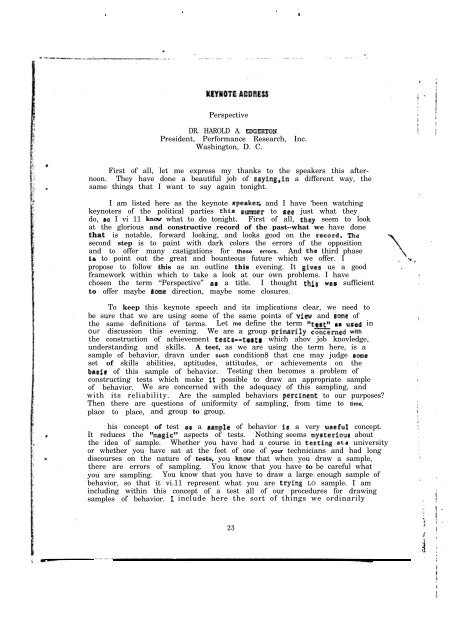Technical Report - International Military Testing Association
Technical Report - International Military Testing Association
Technical Report - International Military Testing Association
Create successful ePaper yourself
Turn your PDF publications into a flip-book with our unique Google optimized e-Paper software.
. ,<br />
. .<br />
Perspective<br />
DR. HAROLD A. ED!XXION<br />
President, Performance Research, Inc.<br />
Washington, D. C.<br />
First of all, let me express my thanks to the speakers this afternoon.<br />
They have done a beautiful job of saying,in a different way, the<br />
same things that I want to say again tonight.<br />
I am listed here as the keynote speaket, and I have ‘been watching<br />
keynoters of the political parties this 8Umner to see just what they<br />
do, 80 I vi 11 know what to do tonight. First of all, th’ey seem to look<br />
at the glorious and constructive record of the past--what we have done<br />
that is notable, forward looking, and looks good on the ,record. Tha<br />
second step is to paint with dark colors the errors of the opposition<br />
and to offer many castigations for these errors. And thse third phase<br />
ie to point out the great and bounteous future which we offer. I<br />
propose to follow this as an outline this evening. It gfves us a good ,<br />
framework within which to take a look at our own problems. I have<br />
chosen the term “Perspective” aa a title. I thought thins was sufficient<br />
to offer maybe some direction, maybe some closures.<br />
To keep this keynote speech and its implications clear, we need to<br />
be sure that we are using some of the same points of view and some of<br />
the same definitions of terms. Let me define the term “teat” aa ueed in<br />
our discussion this evening. We are a group primarily ci=rned with<br />
the construction of achievement tests--testa which ahov job knovledge,<br />
understanding and skills. A teet, as we are using the term here, is a<br />
sample of behavior, dravn under such condition8 that cne may judge some<br />
set of skills abilities, aptitudes, attitudes, or achievements on the<br />
basic of this sample of behavior. <strong>Testing</strong> then becomes a problem of<br />
constructing tests which make it possible to draw an appropriate sample<br />
of behavior. We are concerned with the adequacy of this sampling, and<br />
with its reliability. Are the sampled behaviors percfnent to our purposes?<br />
Then there are questions of uniformity of sampling, from time to time,<br />
place to place, and group to group.<br />
his concept of test ae a sample of behavior ia a very useful concept.<br />
It reduces the %.agic” aspects of tests. Nothing seems mysteriotre about<br />
the idea of sample. Whether you have had a course in tee:ting ata university<br />
or whether you have sat at the feet of one of your technicians and had long<br />
discourses on the nature of tests, you know that when you draw a sample,<br />
there are errors of sampling. You know that you have to be careful what<br />
you are sampling. You know that you have to draw a large enough sample of<br />
behavior, so that it vi.11 represent what you are tryfng LO sample. I am<br />
including within this concept of a test all of our procedures for drawing<br />
samples of behavior. I include here the sort of things we ordinarily<br />
23<br />
\ b.,<br />
.<br />
.









